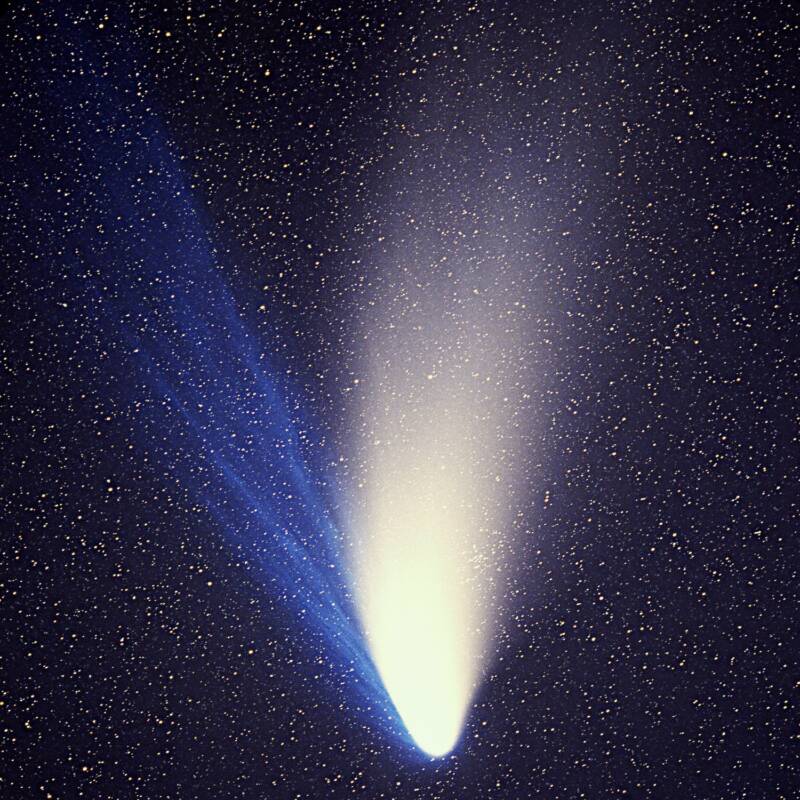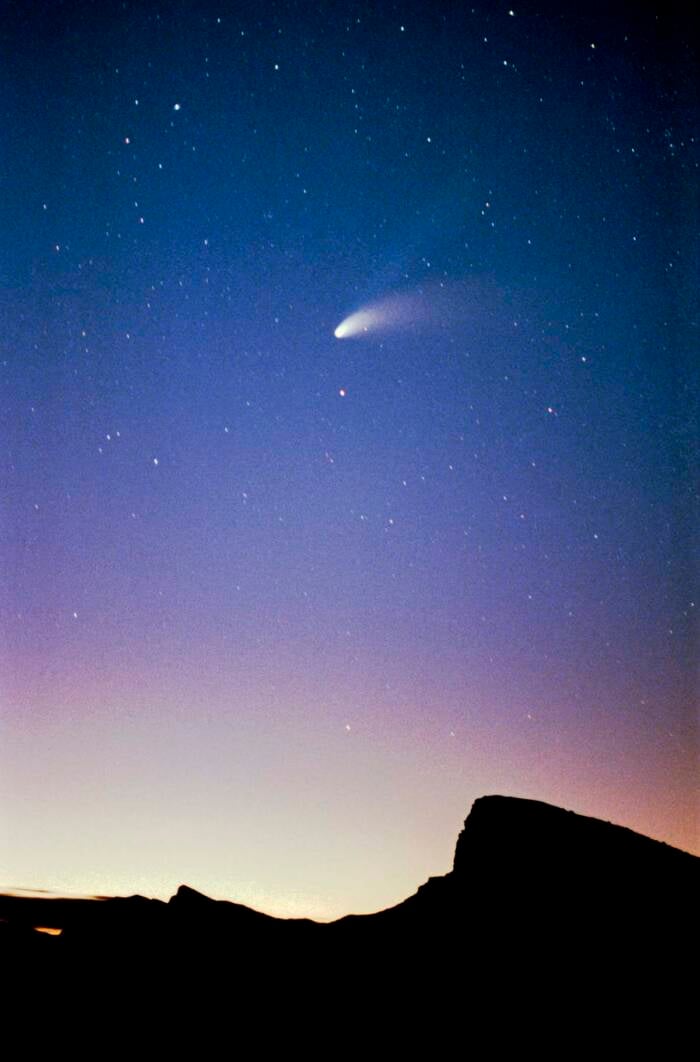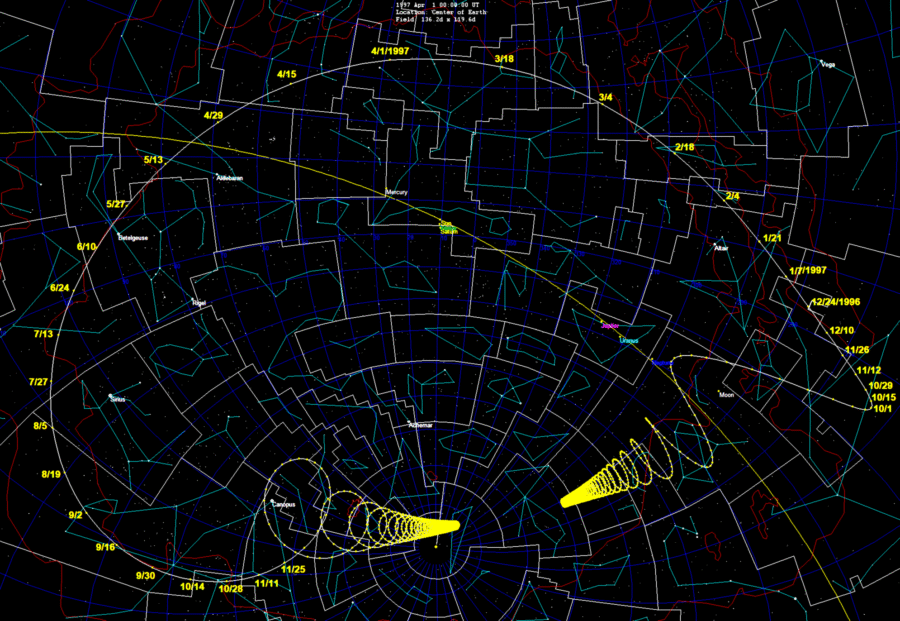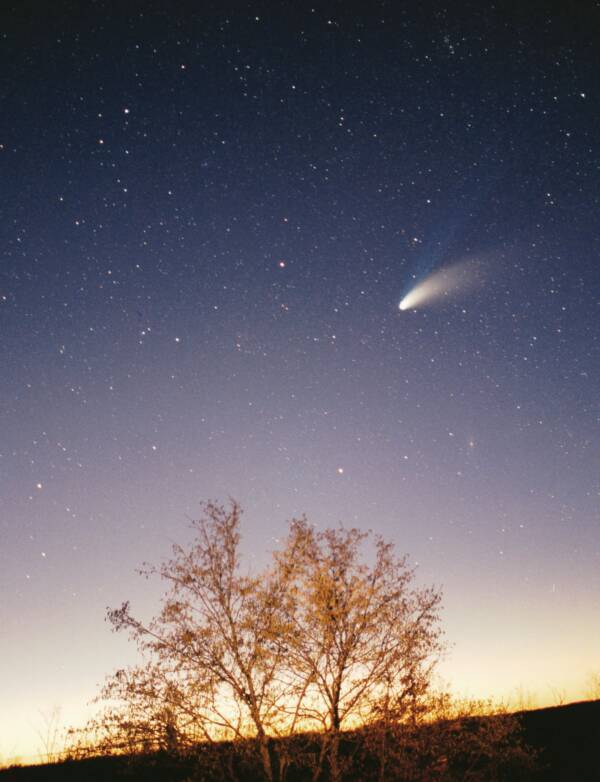A spectacularly bright comet that flew close to Earth, Hale-Bopp thrilled scientists and amateur astronomers alike. Sadly, it also led 39 members of the Heaven's Gate cult to commit mass suicide.

Johannes-Kepler-Observatory/Wikimedia CommonsOne of the brightest comets to ever fly near Earth, Hale-Bopp became an early internet sensation.
In 1995, something new appeared in the night sky. Two amateur astronomers spotted a notably bright moving dot. The scientific community quickly realized that the moving dot was a comet. And soon, the spectacular comet would be visible to the naked eye.
That comet, known as Hale-Bopp, remained observable for 18 months.
How does Hale-Bopp compare with other comets? Unlike Halley’s Comet, which makes regular visits near Earth about every 75 years, Hale-Bopp won’t return for thousands of years. Hale-Bopp is also massive — five times the size of the celestial object that likely caused the extinction of the dinosaurs.
But the new discovery, which was widely celebrated on the early internet, also came with a dark side. As the comet inched closer to Earth, members of the Heaven’s Gate cult committed mass suicide in California to ascend to a UFO that they believed was trailing behind Hale-Bopp.
The Discovery Of The Hale-Bopp Comet
On July 23, 1995, amateur astronomer Alan Hale pointed a secondhand telescope at the sky from his home in Cloudcroft, New Mexico. At the same time, another amateur astronomer named Thomas Bopp was also closely studying the night sky from his Arizona home.
“When I turned the telescope to the globular star cluster M70 in Sagittarius I noticed a dimmer, fuzzy object in the same field of view,” recalled Hale.
Both Hale and Bopp reported what they saw to the International Astronomical Union’s Central Bureau for Astronomical Telegrams. Soon, the International Astronomical Union made it official: The astronomers had discovered comet C/1995 O1. It would soon bear the names of the men who first spotted it: the Hale-Bopp comet, or Comet Hale-Bopp.
“I was very excited about the discovery,” Hale said. “I had no way of knowing at the time that it would turn out to be such a bright object.”
The comet’s discovery was also notable for another reason: Hale-Bopp was farther from Earth than any other comet that amateurs saw first.

Wikimedia CommonsAn image of Hale-Bopp, captured from Death Valley, California in April 1997.
For an 18-month period from May 1996 to December 1997, Hale-Bopp traveled the Earth’s sky. In contrast, Halley’s Comet usually only remains visible to the naked eye for a matter of weeks or a few months.
The Fascinating Science Behind Hale-Bopp
The discovery of a new comet gave scientists an opportunity to expand their knowledge of astronomy. Researchers determined that Hale-Bopp was around 4 billion years old. It likely formed near Jupiter before it was flung into the Oort cloud at the far edge of the solar system.
That made Hale-Bopp a long-period comet. These comets, which travel astonishing distances, take more than 200 years to orbit the Sun. In contrast, short-period comets return more often. For example, Halley’s Comet, which last appeared in 1986, is expected to reappear again in 2061.
As Hale-Bopp moved closer to Earth, scientists were stunned to see how bright it was. “It’s been kind of nerve-racking to sit through all those months wondering if the comet would fizzle,” Hale told Time.
But Hale-Bopp did not fizzle. In fact, it was 1,000 times brighter than Halley’s Comet at the same distance. And a massive dust outburst followed the comet, stretching eight times as much as previously seen comets.
“The surface of Hale-Bopp’s nucleus must be an incredibly dynamic place, with ‘vents’ being turned on and off as new patches of icy material are rotated into sunlight for the first time,” said Harold Weaver, an astrophysicist working with Johns Hopkins University.

Wikimedia CommonsStar maps charted Comet Hale-Bopp’s path in 1997.
After making its closest approach to Earth on March 22, 1997, Hale-Bopp started heading back toward the edge of the solar system. In four years, it traveled 1.2 billion miles away from Earth, passing Saturn’s orbit.
In 2001, the European Southern Observatory reported on the comet’s progress: “The large ‘dirty snowball’ nucleus of ice and dust (probably about 50 km (31 miles) diameter) continues to be active, despite the very low temperature where it is now. This is quite unusual for a comet.”
Hale-Bopp And The Internet Age
The Hale-Bopp comet made a splash during the early internet age, as ordinary people could easily track the comet’s movements across space.
“The show in the heavens is only part of the picture,” Scientific American reported in 1997, “Hale-Bopp has also created a sensation on the Internet.”
As the science publication noted, “There are a multitude of Web sites containing information on Hale-Bopp; they are attracting so many visitors that they are causing a traffic jam on the Internet.”

Philipp Salzgeber/Wikimedia CommonsBest viewed by people who lived in the Northern Hemisphere, Comet Hale-Bopp was reportedly observed by at least 69 percent of Americans by April 1997.
The comet generated such interest that NASA’s Hale-Bopp homepage counted more than 1.2 million visitors daily in late March 1997.
Scientific American suggested that those interested in the comet should try to see it with their own eyes on clear nights or do “a bit of Web surfing” to see pictures of the celestial object on cloudy nights.
Unfortunately, all the attention surrounding Hale-Bopp eventually caught the eye of Heaven’s Gate cult leader Marshall Applewhite.
Inside The Heaven’s Gate Cult
Years before the appearance of the Hale-Bopp comet, Marshall Applewhite built a cult that blended asceticism, science fiction, and Christianity.
Who was Marshall Applewhite? A former Army soldier and failed actor, Applewhite grew obsessed with Biblical prophecies and some more obscure spiritual beliefs when his professional and personal life began falling apart.
By 1975, Applewhite had walked away from his former life and started a group that promised an alien spaceship would eventually arrive to bring him and his followers to salvation in the “next kingdom.” The cult leader declared the physical human body a mere vessel and claimed that a UFO would transport his estimated 200 followers to the “next level.”
The spacecraft never showed. Most of the followers left the group.

Brooks Kraft LLC/Sygma via Getty ImagesBefore his death, cult leader Marshall Applewhite preached that the Hale-Bopp comet was followed by a spaceship that would bring him and his followers to the “next level.”
By the 1990s, Applewhite had attracted some new followers for his Heaven’s Gate cult, using the internet to recruit potential members. And when the Hale-Bopp comet appeared in the sky, Applewhite declared that an Earth-saving spaceship had hidden itself behind the comet.
Anyone could be captivated by Hale-Bopp moving across the sky, especially those who had the best views from the Northern Hemisphere. But Heaven’s Gate cult members believed that the comet’s tail concealed intergalactic travelers who would not only take them to the “next kingdom” but also help them evacuate Earth before it was “recycled.”
As the comet approached Earth, Applewhite and his followers prepared to die by suicide, as they believed that would allow them to board the fabled spacecraft. They moved into a mansion in Rancho Santa Fe, California. Cult members bought identical black tracksuits and Nike sneakers. And in March 1997, Applewhite told his followers that it was time to ascend to the comet.
Over a period of a few days, 39 members of the Heaven’s Gate cult died after consuming applesauce or pudding heavily laced with barbiturates and placing bags over their heads to ensure asphyxiation. They killed themselves in groups, and Applewhite was one of the last members to die.
“According to material the group posted on its internet site, the timing of the suicides were probably related to the arrival of the Hale-Bopp comet, which members seemed to regard as a cosmic emissary beckoning them to another world,” reported The New York Times.
The Legacy Of The Hale-Bopp Comet
Decades later, the “Great Comet of 1997” remains closely linked to the Heaven’s Gate cult and their tragic mass suicide in public memory.
Around the time the comet flew close to Earth, the early internet offered an exciting, innovative tool to interact with an important new scientific discovery. Millions learned about the comet online, and some internet users also uploaded their own photos of the celestial object to share. NASA websites racked up visits, showing the power of the new technology.
But the internet also became a tool for Applewhite and his Heaven’s Gate cult to popularize their dangerous theories about the comet. The cult’s website promoted their beliefs to a wide audience. And Heaven’s Gate followers were so certain that the comet hid an alien spaceship that they ended their own lives just to board the supposed vehicle.

Heaven’s Gate WebsiteThe Heaven’s Gate website, which is still active today, prominently discusses the Hale-Bopp comet.
By the end of 1997, Hale-Bopp had vanished from Earth’s night sky. Hale-Bopp is due to make its next appearance in the year 4385.
Next, discover some of the most fascinating facts about space. Then, read about some of history’s most deranged cult leaders.





